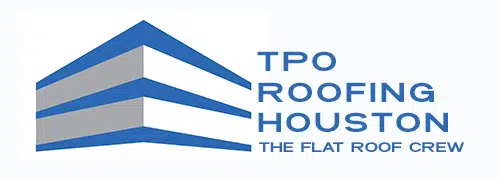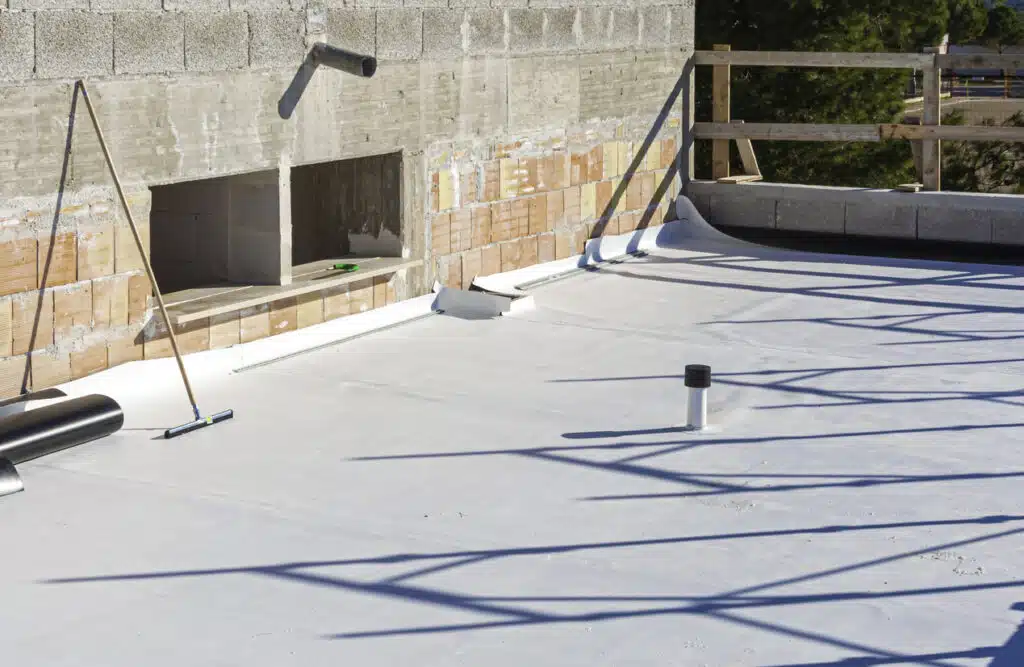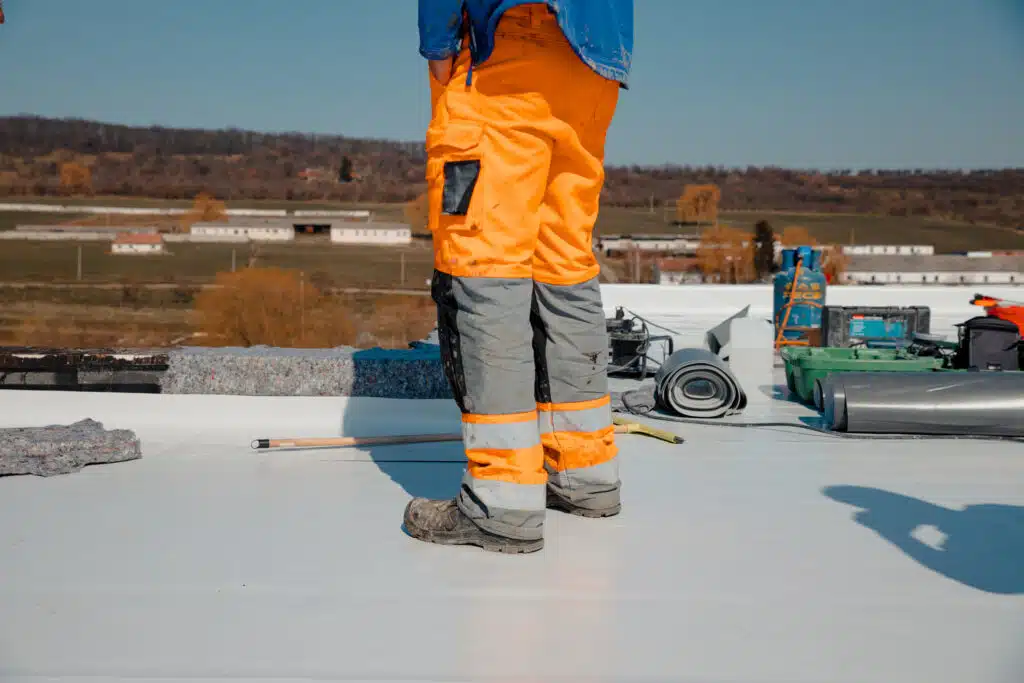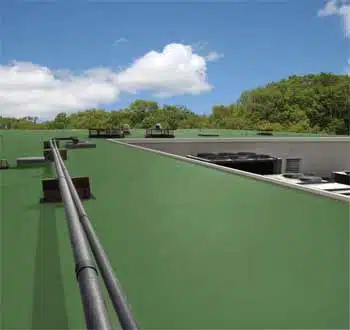Commercial flat roofs are common in urban landscapes. They are a popular choice for businesses, warehouses, and other commercial buildings.
But what makes them so prevalent?
The answer lies in their practicality and versatility. Commercial flat roofs offer many benefits, from easy maintenance to cost-effectiveness.
However, their installation is a complex process. It requires a deep understanding of roofing systems and materials. This is where a commercial flat roof installer comes into play.
A professional installer can guide you through the myriad of choices. They can help you select the right materials and ensure proper installation. This is crucial for the longevity and performance of your roof.
This guide is for homeowners, business managers, and construction project managers. It aims to provide a comprehensive understanding of commercial flat roofs, enabling you to make informed decisions.
Understanding Commercial Flat Roofing
Commercial flat roofing is a staple in the construction world. Its flat design offers many advantages. From space efficiency to ease of installation, the benefits are vast.
One of the main reasons for its popularity is cost-effectiveness. Flat roofs typically require fewer materials than pitched roofs. This makes them a budget-friendly option for many businesses.
Another key advantage is their accessibility. Flat roofs provide a safe platform for maintenance and repairs. They also offer opportunities for additional uses, like rooftop gardens or solar panel installations.
It’s essential to understand the unique aspects of commercial flat roofing systems. These roofs have specific design considerations and material requirements. Proper drainage systems and insulation are critical components.
Materials options vary depending on environmental needs and budget. Single-ply membranes, such as TPO and EPDM, are popular choices. These materials are lightweight, durable, and relatively easy to install.
Overall, understanding commercial flat roofing involves considering various factors. These include materials, installation methods, and potential uses. Each element plays a role in the roof’s performance and longevity.
The Basics of Commercial Flat Roofs
Commercial flat roofs have a horizontal profile, providing a modern, streamlined aesthetic. Despite the name, these roofs are not perfectly flat.
Flat roofs have a slight slope to ensure proper drainage. This is crucial for preventing water pooling and potential damage. A well-designed slope helps manage water efficiently and extends roof life.
These roofs often feature layers of materials for added protection, such as waterproof membranes and insulation. Each layer serves a specific purpose, contributing to the roof’s durability and thermal performance.
Common Materials Used in Commercial Flat Roofing
Choosing the right material is vital for any flat roof project. Here are some of the most common materials used in commercial flat roofing:
- TPO (Thermoplastic Olefin): Known for its energy efficiency and UV-reight resistance.
- PVC (Polyvinyl Chloride): Offers excellent chemical resistance and durability.
- EPDM (Ethylene Propylene Diene Monomer): Highly flexible and weather resistant.
TPO is favored for its environmental benefits and cost-effectiveness. Its reflective surface helps in reducing energy costs. This makes it a popular choice for environmentally conscious businesses.
PVC is often chosen for its strength and longevity. It’s particularly useful in areas with chemical exposure. However, it may have a higher initial cost compared to other materials.
EPDM is celebrated for its flexibility and ease of installation. Its ability to withstand extreme temperatures makes it ideal for varying climates. While installation might be more straightforward, regular maintenance is still necessary.
When selecting materials, consider the building’s location and specific needs. This ensures the roof can withstand environmental challenges. A knowledgeable installer can provide valuable insights for the best choice.
Advantages of Prefabricated Single-Ply Roofing Systems
Prefabricated single-ply roofing systems are revolutionizing commercial roofing. One of their most significant benefits is the quick installation, which reduces labor costs and minimizes business disruptions.
These roofing systems are fabricated off-site, ensuring high precision and quality control. As a result, there is less chance of errors during installation.
Another significant advantage is their lightweight nature. This reduces the load on the building’s structure. It is particularly beneficial for older structures or those with limited load-bearing capacity.
Prefabricated systems are often designed for durability and longevity. They resist a variety of environmental stresses, including UV exposure and extreme temperatures. This durability makes them a sound investment for property owners.
The environmental benefits are also noteworthy. Many prefabricated roofing materials are recyclable, contributing to sustainability. Moreover, they often feature reflective surfaces that help decrease energy consumption.
Key advantages of prefabricated single-ply roofing systems include:
- Quick installation – Faster than traditional methods.
- Quality assurance – Fabricated under controlled conditions.
- Weight reduction – Lowers structural impact.
- Environmental sustainability – Recyclable and energy-efficient options.
These attributes make prefabricated systems an excellent choice for modern commercial buildings. They align with both economic and environmental goals.
The Installation Process of Commercial Flat Roofs
Installing a commercial flat roof involves several critical steps. Each phase requires meticulous attention to detail. Proper execution ensures the roof’s longevity and performance.
Pre-Installation Considerations and Site Inspection
Thorough preparation is essential before any installation work begins. This starts with a detailed site inspection, during which potential obstacles or problem areas are identified.
The inspection helps inform the best materials and techniques to use. It also considers the building’s current condition. These insights guide contractors in designing an effective roofing solution tailored to the site.
Proper planning involves selecting suitable materials. Climate conditions, existing building structures, and budget constraints all influence material choices. Ensuring compatibility with the current architecture is key for optimal performance.
Step-by-Step Guide to Flat Roof Installation
The flat roof installation process commences with a clean slate. This means clearing the existing roof surface of any debris or old materials. A clean base is crucial for the new materials to adhere correctly.
Next, insulation layers are installed. This step is essential for thermal regulation and energy efficiency. The insulation also benefits soundproofing, which can be advantageous in bustling urban settings.
Following insulation, a vapor barrier is applied. This prevents moisture ingress, safeguarding the building’s interior from potential water damage. Proper barrier application is crucial for ensuring a waterproof seal.
Once the prep work is complete, the chosen roofing material is laid. This process should be carefully executed to avoid air pockets or wrinkles. Each material section is precisely cut and fixed to achieve a seamless surface.
Finally, attention turns to details, such as flashings and sealants. These elements are installed to fortify areas vulnerable to water intrusion. Proper sealing around edges and penetrations ensures a leak-proof finish.
The final step is a thorough inspection of the completed roof. This evaluation checks for any issues and confirms that the installation meets industry standards. Once verified, the commercial flat roof is ready to deliver years of reliable service.
Maintenance and Longevity of Commercial Flat Roofs
Commercial flat roofs require regular care to enhance their lifespan. Routine maintenance helps identify potential issues early, reducing costly repairs. Proactive attention to these roofs ensures their reliability and efficiency.
Several maintenance practices are vital for flat roofs. These tasks should be scheduled regularly to prevent deterioration. Even minor neglect can lead to significant problems over time.
Common maintenance tasks include debris removal, inspecting drainage systems, and checking for leaks. Keeping the roof clean and clear helps maintain its integrity. Regular checks can extend a roof’s usable life considerably.
Here’s a quick overview of essential maintenance tasks:
- Debris removal: Keep gutters and drains clear for efficient water flow.
- Visual inspections: Check for signs of damage, such as cracks or punctures.
- Sealant inspection: Ensure all joints and penetrations are watertight.
- Roof membrane checks: Look for any wear and tear or blistering.
Regular Maintenance Schedule and Practices
A regular maintenance schedule is essential to keep a flat roof in prime condition. Establishing a consistent routine aids in spotting issues before they escalate. Early detection is key to cost-effective roof management.
Experts recommend scheduling maintenance at least twice a year. However, some variables may require more frequent checks. Factors such as location, climate, and roof use affect the schedule.
Practices include a thorough cleaning and full inspection after severe weather. Harsh conditions often leave debris and hidden damage. Addressing these promptly saves both time and money.
Assessing Repair Versus Replacement
Deciding between repairing and replacing a roof can be challenging. Knowing when one is more appropriate than the other can save resources. This decision impacts the building’s safety and operating costs.
Several factors influence whether repair or replacement is the best option. The roof’s age, extent of damage, and budgetary constraints play a vital role. Assessing these helps determine the most viable approach.
If damage is minor and isolated, repairs might suffice. However, widespread issues or frequent leaks suggest a replacement is necessary. Commercial TPO Roof Replacement often costs more initially but provides a longer-term solution.
Ultimately, consulting with a roofing specialist is invaluable. They can provide detailed assessments and recommend the best course of action. Their expertise helps ensure the chosen solution aligns with both needs and budget.
Cost Considerations and Energy Efficiency
Investing in a commercial flat roof involves weighing both cost and energy efficiency. Understanding these factors helps make informed decisions. Cost-effective solutions can also contribute to long-term savings.
Several elements influence the overall expense of a roofing project. Material choice, labor, and building size are primary considerations. Installation complexity and local regulations may also affect the price.
Here’s a quick breakdown of what impacts cost:
- Material costs: The type and quality of roofing materials vary significantly in price.
- Labor expenses: Skilled labor is critical for proper installation, affecting total expenditure.
- Building specifications: Larger or more complex structures increase the amount of required materials.
- Permitting fees: Compliance with local building codes may involve additional costs.
Choosing energy-efficient roofing solutions can reduce utility bills. A roof’s ability to insulate and reflect sunlight makes a noticeable impact. These features can lead to significant annual savings.
Factors Influencing the Cost of Installation
Material selection plays a crucial role in determining installation costs. Premium materials, while pricier, often offer superior durability. Weighing initial costs against long-term benefits aids in decision-making.
Labor is another significant cost component. Hiring experienced contractors ensures quality workmanship. However, high-skilled labor may command higher wages, reflecting in the overall expense.
Building size and complexity can also drive costs upward. Larger roofs require more materials and labor hours. Unique architectural features or difficult access may further complicate installation.
How Roofing Choices Affect Energy Consumption
The type of roof installed significantly affects energy efficiency. Materials with high thermal resistance reduce heat transfer. This decreases the reliance on heating and cooling systems.
Reflective roofing materials help combat solar heat gain. By reflecting sunlight, these materials reduce cooling needs in warm climates. Similarly, effective insulation plays a key role in energy conservation.
Choosing the right roofing system can lower operating costs. Energy-efficient roofs offer environmental benefits, reducing a building’s carbon footprint. These eco-friendly choices align with growing energy concerns worldwide.
Choosing the Right Commercial Flat Roof Installer
Selecting a qualified commercial flat roof installer is crucial. The right choice ensures the success and longevity of your roofing project. Certain factors should be considered during the selection process.
Experience should be a top criterion. An installer with a proven track record offers reliability. Check for a history of successful projects similar to yours.
Reputation is equally essential. Ask for references and read reviews. Good reviews often indicate trustworthy services and client satisfaction.
Additionally, verify the contractor’s credentials:
- Licensing and insurance: Ensure they have proper licenses and adequate insurance coverage.
- Professional affiliations: Membership in trade associations can signify commitment to quality.
- Training and certifications: Check for up-to-date certifications on roofing systems they install.
These credentials demonstrate competence and professionalism, ensuring a high-quality outcome.
What to Look for in a Roofing Contractor
Focus on the contractor’s expertise first. A knowledgeable Flat Roof installer understands various roofing materials and techniques. They can offer guidance tailored to your specific needs.
Communication is another key factor. A contractor who listens and responds promptly fosters trust. Transparent dialogue about project timelines and expectations is essential.
Finally, consider the contractor’s resource availability. Adequate resources mean timely project completion and quality assurance. A well-resourced contractor can handle unexpected issues competently.
The Importance of Warranties and Certifications
Warranties protect your investment in the long run. They cover potential defects or issues post-installation. Ensure your contractor provides a comprehensive warranty for peace of mind.
Certifications highlight a contractor’s competencies. They prove proficiency in handling specific roofing materials and systems. Working with certified professionals ensures adherence to industry standards.
Inquire about both warranties and certifications before hiring. Verify the duration and coverage details. A solid warranty combined with proper certifications safeguards your roofing project’s success.
Why TPO Roofing Houston Should Be Your Go-To for Flat Roof Installation
In closing, it’s clear that choosing the right partner for your commercial flat roof installation is not just about ensuring your building is well-protected; it’s about investing in the future of your business. This is where TPO Roofing Houston stands out as the beacon of reliability and expertise in commercial roofing.
With a highly skilled team specializing in the latest TPO roofing technologies, TPO Roofing Houston brings innovation, efficiency, and durability to every project. Our commitment to excellence means you get a roofing solution that meets your immediate needs and anticipates the demands of tomorrow’s weather and architectural trends.
From our meticulous approach to installation to our unwavering support in maintenance and repair, we understand that your commercial flat roof is more than just a structure; it’s a vital part of your business’s success. By choosing TPO Roofing Houston, you’re not just getting a service; you’re gaining a partner who values the integrity of your business as much as you do.
Having a robust, energy-efficient, and cost-effective flat roof can set your business apart in a city where every day presents new challenges and opportunities. Whether you’re looking to upgrade, repair, or install a new flat roof, our team at TPO Roofing Houston is ready to bring your vision to life with unparalleled quality and service. Don’t settle for anything less than the best for your business. Call TPO Roofing Houston today for your flat roof installation needs and step into a future where your building’s potential is realized to its fullest.





